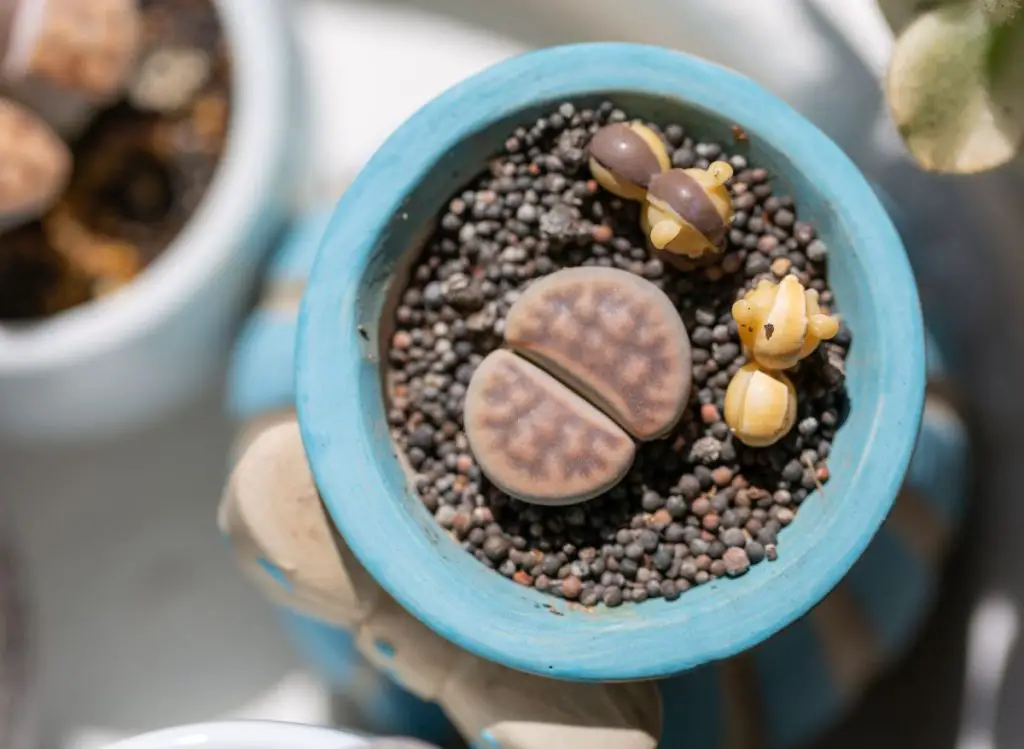
Lithops is a genus of succulent plants and a member of the Aizoaceae family that has caught the attention of many gardeners due to its unique and stunning appearance. Also known as living stones, these cute little plants are native to South Africa, and they are a fascinating addition to any garden or indoor plant collection.
But when do lithops flower? Most Lithops typically flower during autumn and early winter and produce pale orange, daisy-like yellow, or white flowers with many petals. During sunny days, the flowers bloom in the afternoon and close again in late afternoon (Source: University of Wisconsin-Madison Division of Extension)
Read on to explore in detail the flowering process of lithops and what you need to know to get them to bloom. Also, check out this article to understand the fascinating lithops growth cycle.
When Do Lithops Flower?
Lithops often bloom in autumn or early winter, although this depends on the geographical region and the specific species. In ideal conditions, they can bloom twice a year. Generally, flowering is triggered by the amount of light, temperature, and soil moisture, and it is essential to ensure that these factors are balanced to encourage blooming.
The flowers of lithops emerge from the center and can last for several days, producing stunning pink, white, or yellow blossoms that stand in stark contrast to their muted-colored bodies.
An important factor that plays a vital role in the blooming of lithops is age. These plants typically flower when they reach maturity, which can take anywhere from 2 to 4 years. As lithops grow, they develop with a split body that divides into two leaves known as the “hinge line.” Once they reach maturity, they will produce their first flower. After this, they will continue to bloom year after year, given the optimal growth conditions.
How Do You Get Your Lithops To Bloom?
To encourage lithops to flower, you need to provide them with the right conditions. They thrive in well-draining soil that allows excess water to drain away quickly. Overwatering is the most common reason lithops fail to flower, so ensure that you don’t keep the soil too damp.
Lithops start into growth in autumn, corresponding to early September, so giving your lithops a good watering during this time is recommended.
In addition, Lithops plants need plenty of light, and a sunny spot indoors or outdoors, depending on the region, is crucial. They will struggle in low light and may not bloom. As for temperature, lithops prefer warmer temperatures during the day and cooler nights, so try to mimic their natural environment as closely as possible.
Another way to encourage Lithops plants to flower is to give them a period of rest during the summer months. During summer, it is essential to reduce watering to almost nothing and make sure the plants receive less light.
How Many Times Do Lithops Flower?
Lithops generally rebloom every year. And, while lithops can flower multiple times a year, it is worth noting that each flowering drains the plant of energy. I recommend you allow living stones time to recover fully between blooming cycles. This means allowing them to rest between flowerings by reducing watering frequency and providing it with the right temperature and light conditions.
Remember to remove dead flowers to avoid them drawing energy away from the plant.

What Time Of Year Do Lithops Split?
Lithops will generally split when ready to produce new leaves or flower buds. Typically, Lithops plants will flower in autumn or winter, although this may vary depending on the species and the climate conditions.
Lithops are native to Africa, specifically in regions that experience harsh living conditions such as extreme heat and drought. Interestingly, they have adapted their unique appearance to survive in these harsh conditions as a way of retaining water.
Lithops have two opposite leaves that store water, and these two leaves form the plant’s “body,” which is the reason why they are sometimes called “butt plants.” A Lithops plant can grow to be around 1 inch (2.54 cm), and they produce white to yellow flowers that have a sweet fragrance.
Caring For Lithops
It is essential to note that Lithops are incredibly susceptible to rot, so make sure you are careful with the amount of water you give them. Only water Lithops when the soil is dry to the touch. Overwatering can lead to their roots becoming waterlogged, which can eventually cause them to rot.
Also, Lithops prefer well-draining soil for healthy growth. Lithops don’t require fertilizers as most fertilizers contain too much nitrogen, which is harmful to the plant. However, high-potassium, low-nitrogen fertilizer helps encourage flowering (Source: Spruce)
The flowering period for each Lithops plant can last anywhere from a week to a month, depending on the growing conditions. It is important to note that the flowering period can also be affected by environmental factors, including the amount of light and water the plant receives. I encourage you to water them properly.
What to read next:
- Effective Ways Of Dealing With Splitting Lithops.
- How Long Do Succulents Typically Live Without Water?
- How To Clean Up Overgrown Succulents And Bring Them Back to Life: A Quick and helpful guide.
Wrapping Up
Lithops are intriguing plants that can bring a unique look to your garden or home decor. They flower in the autumn-winter period, but their flowering time can vary for each species and the environmental factors each plant has been exposed to.
To ensure that your Lithops plants have the best chance of flowering, make sure to give them a period of rest during the summer months and be careful with watering.
Contributing factors in their flowering include age, light, temperature, and humidity. I also believe that with proper care and patience, lithops can produce beautiful flowers that are sure to catch the eye and win hearts.

